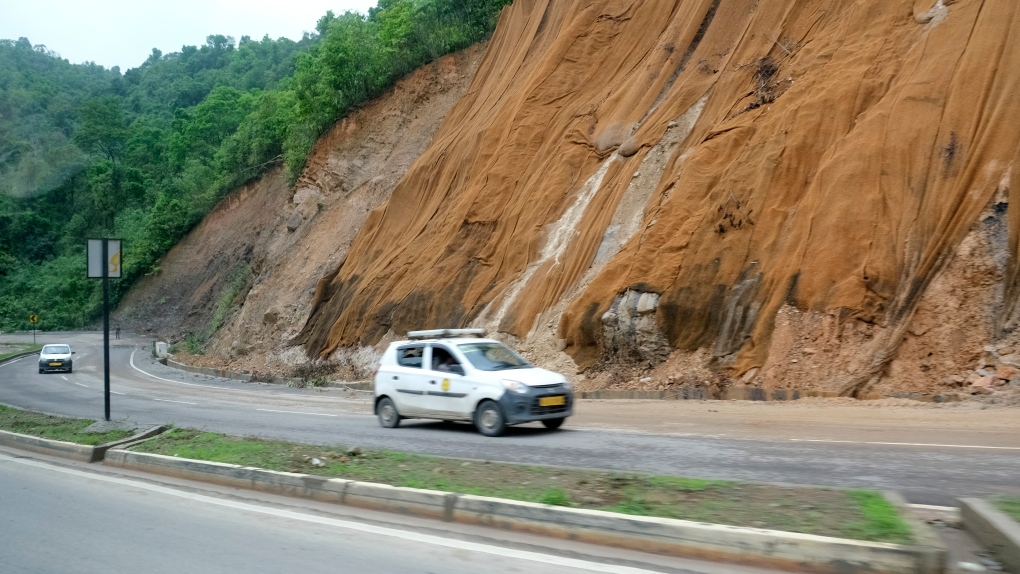
Canada, G7 urge 'all parties' to de-escalate in growing Mideast conflict
Canada called for "all parties" to de-escalate rising tensions in the Mideast following an apparent Israeli drone attack against Iran overnight.
Pounding rain following weeks of heavy downpours triggered a mudslide in northeast India that killed at least 14 people and left more than 30 others missing, authorities said Thursday.
Disaster response workers, police and local villagers were trying to rescue those buried under the debris in Noney, a town near Imphal, the capital of Manipur state.
Seven of the confirmed dead were members of the Territorial Army, state chief minister N. Biren Singh said. He said five Indian Railway officials were among those feared missing.
A railway project is being constructed in the area, where there is a rebel insurgency, and the army personnel were providing security for railway officials overseeing the project. The state's decades-old insurgency seeks a separate homeland for ethnic and tribal groups.
Continuous rainfall over the past three weeks has wreaked havoc across India's northeast, which has eight states and 45 million people, and in neighboring Bangladesh.
An estimated total of about 200 people have been killed in heavy downpours and mudslides in states including Assam, Manipur, Tripura and Sikkim, while 42 people have died in Bangladesh since May 17. Hundreds of thousands of people have been displaced.
Scientists say climate change is a factor behind the erratic, early rains that triggered the unprecedented floods. Monsoon rains in South Asia typically begin in June, but torrential rain lashed northeastern India and Bangladesh as early as March this year.
With rising global temperatures due to climate change, experts say the monsoon season is becoming more variable, meaning that much of the rain that would typically fall throughout the season arrives in a shorter period.

Canada called for "all parties" to de-escalate rising tensions in the Mideast following an apparent Israeli drone attack against Iran overnight.
Hospital chaplain J.S. Park opens up about death, grief and hearing thousands of last words, and shares his advice for the living.
A woman who recently moved to Canada from India was searching for a job when she got caught in an online job scam and lost $15,000.
More money will land in the pockets of some Canadian families on Friday for the latest Canada Child Benefit installment.
The World Health Organization and around 500 experts have agreed for the first time on what it means for a disease to spread through the air, in a bid to avoid the confusion early in the COVID-19 pandemic that some scientists have said cost lives.
On Friday, the pop star released her 11th album and at 2 a.m. Eastern, she released "The Tortured Poets Department: The Anthology," featuring 15 additional songs.
The United States told the Group of Seven foreign ministers on Friday that it received 'last minute' information from Israel about a drone action in Iran, but didn't participate in the apparent attack, officials said.
American millionaire Jonathan Lehrer, one of two men charged in the killings of a Canadian couple in Dominica, has been denied bail.
Group of Seven foreign ministers warned of new sanctions against Iran on Friday for its drone and missile attack on Israel, and urged both sides to avoid an escalation of the conflict.

At 6'8" and 350 pounds, there is nothing typical about UBC offensive lineman Giovanni Manu, who was born in Tonga and went to high school in Pitt Meadows.
Kevin the cat has been reunited with his family after enduring a harrowing three-day ordeal while lost at Toronto Pearson International Airport earlier this week.
Molly Knight, a grade four student in Nova Scotia, noticed her school library did not have many books on female athletes, so she started her own book drive in hopes of changing that.
Almost 7,000 bars of pure gold were stolen from Pearson International Airport exactly one year ago during an elaborate heist, but so far only a tiny fraction of that stolen loot has been found.
When Les Robertson was walking home from the gym in North Vancouver's Lower Lonsdale neighbourhood three weeks ago, he did a double take. Standing near a burrow it had dug in a vacant lot near East 1st Street and St. Georges Avenue was a yellow-bellied marmot.
A moulting seal who was relocated after drawing daily crowds of onlookers in Greater Victoria has made a surprise return, after what officials described as an 'astonishing' six-day journey.
Just steps from Parliament Hill is a barber shop that for the last 100 years has catered to everyone from prime ministers to tourists.
A high score on a Foo Fighters pinball machine has Edmonton player Dave Formenti on a high.
A compound used to treat sour gas that's been linked to fertility issues in cattle has been found throughout groundwater in the Prairies, according to a new study.
 Nets cover a slope by a road to prevent soil from slipping on the highway near Medziphema, in the northeastern India state of Nagaland, Tuesday, May 17, 2022. Officials in India say more than 10 people have died in floods and mudslides triggered by heavy rains in the country's northeast region. (AP Photo/Yirmiyan Arthur)
Nets cover a slope by a road to prevent soil from slipping on the highway near Medziphema, in the northeastern India state of Nagaland, Tuesday, May 17, 2022. Officials in India say more than 10 people have died in floods and mudslides triggered by heavy rains in the country's northeast region. (AP Photo/Yirmiyan Arthur)